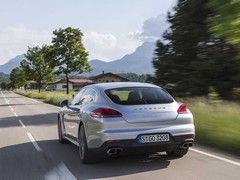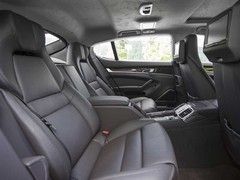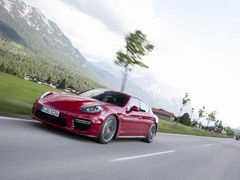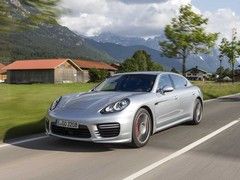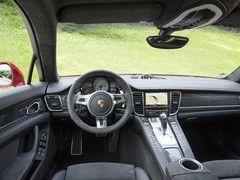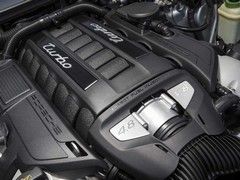Porsche Panamera facelift: Review
Fewer cylinders, more turbos and a 167mph 100mpg hybrid - PH drives the new Porsche Panamera
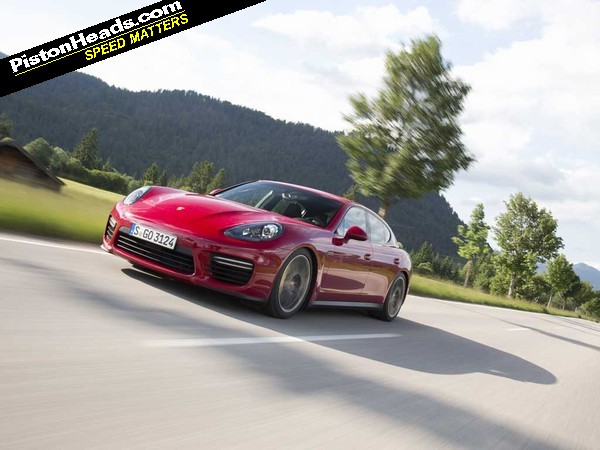
That means it still has uncomfortable angles and still looks bulky at the bum. It means also that as many will loathe its styling as love it. But the presence and unmistakable 'Porscheness' remain and that, I suppose, is entirely the point.
A few extra inches
Bigger changes come under the skin with the introduction of a new 3.0-litre V6 bi-turbo replacing the outgoing 4.8-litre V8 in the S and 4S models. A long-wheelbase Executive version is also added, with an extra 12cm of rear legroom and greater seat adjustment for those customers who buy a sports saloon for the chauffeur to appreciate.
The new E-Hybrid sees its air-cooled NiMH batteries replaced with a water-cooled Li-Ion setup and power up to 95hp at 2,200-2,600rpm and torque at 229lb ft from 0-1,700rpm from the E-motor. That is teamed with a 333hp 3.0-litre supercharged petrol engine of Audi parentage. The result is the kind of spec sheet that looks like a mistake: 167mph, 0-62mph in 5.5 seconds, 91mpg and just 71g/km of CO2.
This is now a proper plug-in, too. The charging kit that comes in the boot can be plugged into a normal mains supply and the battery completely charged in just four hours (or two on a 400v system).
This or a Prius
The hybrid model is certainly an impressive demonstration of technological know-how but it is also surprisingly cohesive to drive.
We tackle the first 30-odd kilometres through town, country and on motorway. We overtake, we sample the full-mash 416hp petrol/electric power splurge. Basically, we drive pretty normally. And return a little under 100mpg. It's astonishing. A more committedly 'eco' colleague records a scarcely creditable 2,400mpg on the same stretch. Yes, really.
On all-season rubber (a no cost option but one that offers the benefit of lower rolling resistance) there's discernibly more push and lots more tyre squeal, but the handling and control still impress - especially given its near 2,100kg kerb weight.
Porsche cites those techno-friendly early adopters and those who wish to enjoy a luxury sports machine with a clear conscience as potential customers. Tax write-off advantages, low BIK (just five per cent) and the ability to dodge the congestion charge might also attract business users and city slickers in the UK. Last year hybrids made up 10 per cent of Panamera sales and this version is a considerable step up in every area.
From eight to six...
The best all rounder is the new V6 S, which we drove in its four-wheel drive incarnation. The engine is based on the carcass of the previous V8, swapping a pair of cylinders for a pair of turbochargers. It delivers 420hp, 383lb ft from 1,750-5,000 rpm and returns over 30mpg.
Lighter, pokier and more efficient, the powerplant sounds good and the turbo delivery gives a massive spread of accessible torque. It has a smoother feel and sound to the V8 which suits the Panamera's luxury credentials at cruise, but it is responsive and muscular when required.
Of course, there are ways to customise the sound, feel and performance of the Panamera at the push of a button or two. Dampers are best left in the softest setting. The sports exhaust adds a certain fruitiness when pressing on but unwelcome boom and bass on the motorway. This is exacerbated, somewhat, by the new function that puts the engine to idle when coasting, rather than maintaining engine revs. That means the tacho needle can be dipping and bobbing a surprising amount without you actually doing anything. But it all helps to improve economy and reduce emissions, of course.
...and seven to eight
Gearbox options are now limited to the seven-speed PDK for the petrol variants and eight-speed Tiptronic for the diesel and the E-Hybrid. Not that either leaves you short-changed, it has to be said. With a proper paddle arrangement, PDK is brilliant when pointing the Panamera up a snaking piece of Alpine asphalt but is also smooth and discreet when in town or on the motorway and left to its own devices.
For sheer driving pleasure, the GTS seems like a PH kind of pick. If the on-paper stats look similar to the 4S (440hp, 383lb ft, 0-62 in 4.4 seconds, top speed 179mph) the gulf in character is surprisingly wide. The GTS sounds and feels harder and tighter from the off. The V8 engine is more strident, the staccato bassline more overtly sporting without being intrusive. The ride is firmer, even in the softer setting, but perfectly acceptable at least on these well-maintained European roads.
The GTS's ability to mask its bulk and girth is remarkable. And while it doesn't ever feel small, it has such accuracy, such grip and such composure that you rarely feel as if you are close to breaching its limits. This in turn encourages you to push harder - just to marvel at the beast's defiance of the laws of physics. I can't help thinking that if you tried to tackle these roads with similar verve in a 'normal' luxury saloon, you'd be in the trees by turn two.
The GTS is without doubt the most enjoyable to drive - it feels somehow more analogue, more involving, despite having just as much electrickery at its disposal. Truth is, however, it is one that sits least comfortably in the range and will definitely be a niche sell in Europe
Beast til last
Our last blast is in the Turbo. While much of the autobahn network is now speed limited, swathes of it between Garmisch and Munich are still mercifully liberated. Sparse traffic enables us to really explore the might of the Turbo's blown V8 - 520hp and an epic 531lb ft of torque, lifted to 568lb ft on overboost.
Short bursts of throttle enable you to head deep into three figures and one longer straight sees an indicated 298km/h - which is about 185mph. The disdainful ease with which it mullers miles and the calm, cool comfort that cocoons it occupants in the process shows the Panamera's range of ability. A proper transcontinental missile, this, for those with pockets deep enough (£108K for starters...).
The one model which was conspicuous by its absence, however, was the diesel. It makes up over 50 per cent of Panamera sales in the UK - even more on the continent. With its £63K price and 45mpg frugality, it's hard to see that changing in the immediate future.
PORSCHE PANAMERA 4S
Engine: 2,997cc V6, twin-turbocharged
Transmission: 7-speed dual-clutch auto (PDK), four-wheel drive
Power: 420hp@6,000rpm
Torque: 384lb ft@1,750-5,500rpm
0-62mph: 4.8 seconds
Top speed: 177mph
Weight: 1,870kg
MPG: 31.2
CO2: 208g/km
Price: £85,721
Gassing Station | General Gassing | Top of Page | What's New | My Stuff

